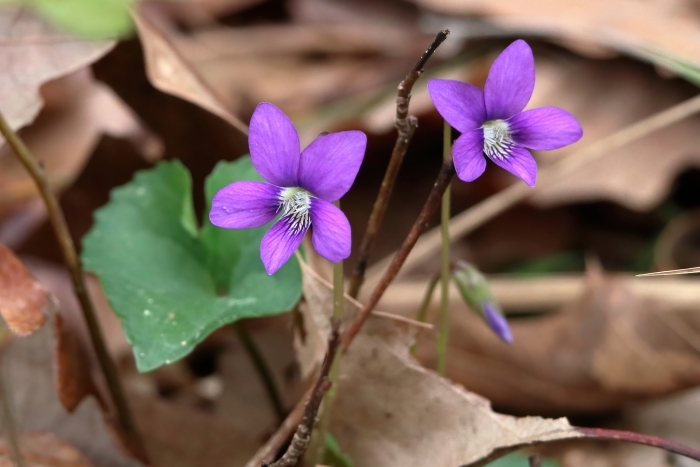Arrowleaf Violet
(Viola sagittata)
Arrowleaf Violet (Viola sagittata)
/
/

Lauren McLaurin
CC BY 4.0
Image By:
Lauren McLaurin
Recorded By:
Copyright:
CC BY 4.0
Copyright Notice:
Photo by: Lauren McLaurin | License Type: CC BY 4.0 | License URL: http://creativecommons.org/licenses/by/4.0/ | Rights Holder: Lauren McLaurin | Publisher: iNaturalist | Date Created: 2021-03-16T11:07:35-07:00 |












































Estimated Native Range
Summary
Viola sagittata, commonly known as Arrowleaf Violet, is a deciduous perennial herb native to open woodlands, meadows, and grassy slopes in Eastern North America. It typically grows to a height of 0.3-0.7 feet (0.09-0.2 meters) and a width of 0.3 feet (0.09 meters). This violet has a distinctive appearance with its stemless form and arrow-shaped leaves that are much longer than wide, with truncate to subcordate bases. The plant produces showy blue to purple flowers in the spring, which are a valuable source of nectar for early-season pollinators.
Arrowleaf Violet is appreciated for its low maintenance and the charming splash of color it brings to woodland gardens, naturalized areas, and borders. It thrives in part shade to full sun and prefers medium moisture, well-drained soils. While it is not aggressive, it can self-seed in favorable conditions, making it suitable for informal plantings. It is also used in native plant gardens and for erosion control due to its fibrous root system. Gardeners should be aware that, like other violets, it can be susceptible to leaf spot diseases and should be monitored for signs of infection.CC BY-SA 4.0
Arrowleaf Violet is appreciated for its low maintenance and the charming splash of color it brings to woodland gardens, naturalized areas, and borders. It thrives in part shade to full sun and prefers medium moisture, well-drained soils. While it is not aggressive, it can self-seed in favorable conditions, making it suitable for informal plantings. It is also used in native plant gardens and for erosion control due to its fibrous root system. Gardeners should be aware that, like other violets, it can be susceptible to leaf spot diseases and should be monitored for signs of infection.CC BY-SA 4.0
Plant Description
- Plant Type: Herb
- Height: 0.3-0.7 feet
- Width: 0.3-0.3 feet
- Growth Rate: Moderate
- Flower Color: Purple
- Flowering Season: Spring, Summer
- Leaf Retention: Evergreen
Growth Requirements
- Sun: Part Shade, Full Sun
- Water: Medium
- Drainage: Fast
Common Uses
Bee Garden, Butterfly Garden, Deer Resistant, Low Maintenance, Showy Flowers
Natural Habitat
Open woodlands, meadows, and grassy slopes in Eastern North America
Other Names
Common Names: Arrow-Leaved Violet, Fringed Violet, Arrowhead Violet, Violette Sagittée, Pilviol
Scientific Names: , Viola sagittata, Viola primulifolia, Viola emarginata, Viola emarginata var. emarginata, Viola emarginata var. acutiloba, Viola dentata, Viola sagittata var. fimbriatula, Viola subsagittata, Viola alleghanensis
GBIF Accepted Name: Viola sagittata Aiton